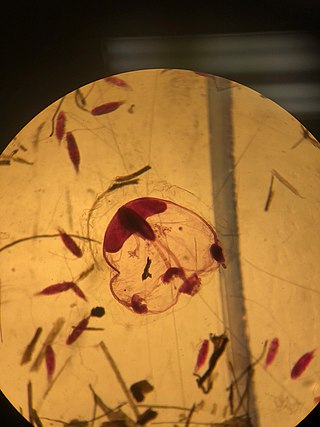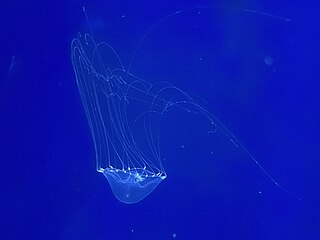
Cnidaria is a phylum under kingdom Animalia containing over 11,000 species of aquatic animals found both in fresh water and marine environments, including jellyfish, hydroids, sea anemones, corals and some of the smallest marine parasites. Their distinguishing features are a decentralized nervous system distributed throughout a gelatinous body and the presence of cnidocytes or cnidoblasts, specialized cells with ejectable flagella used mainly for envenomation and capturing prey. Their bodies consist of mesoglea, a non-living, jelly-like substance, sandwiched between two layers of epithelium that are mostly one cell thick. Cnidarians are also some of the only animals that can reproduce both sexually and asexually.

A polyp in zoology is one of two forms found in the phylum Cnidaria, the other being the medusa. Polyps are roughly cylindrical in shape and elongated at the axis of the vase-shaped body. In solitary polyps, the aboral end is attached to the substrate by means of a disc-like holdfast called a pedal disc, while in colonies of polyps it is connected to other polyps, either directly or indirectly. The oral end contains the mouth, and is surrounded by a circlet of tentacles.

Jellyfish, also known as sea jellies, are the medusa-phase of certain gelatinous members of the subphylum Medusozoa, which is a major part of the phylum Cnidaria.

Aurelia aurita is a species of the family Ulmaridae. All species in the genus are very similar, and it is difficult to identify Aurelia medusae without genetic sampling; most of what follows applies equally to all species of the genus.

Hydrozoa is a taxonomic class of individually very small, predatory animals, some solitary and some colonial, most of which inhabit saline water. The colonies of the colonial species can be large, and in some cases the specialized individual animals cannot survive outside the colony. A few genera within this class live in freshwater habitats. Hydrozoans are related to jellyfish and corals and belong to the phylum Cnidaria.

Obelia is a genus of hydrozoans, a class of mainly marine and some freshwater animal species that have both polyp and medusa stages in their life cycle. Hydrozoa belongs to the phylum Cnidaria, which are aquatic organisms that are relatively simple in structure with a diameter around 1mm. There are currently 120 known species, with more to be discovered. These species are grouped into three broad categories: O. bidentata, O. dichotoma, and O. geniculata. O. longissima was later accepted as a legitimate species, but taxonomy regarding the entire genus is debated over.

Velella is a monospecific genus of hydrozoa in the Porpitidae family. Its only known species is Velella velella, a cosmopolitan free-floating hydrozoan that lives on the surface of the open ocean. It is commonly known by the names sea raft, by-the-wind sailor, purple sail, little sail, or simply Velella.

Medusozoa is a clade in the phylum Cnidaria, and is often considered a subphylum. It includes the classes Hydrozoa, Scyphozoa, Staurozoa and Cubozoa, and possibly the parasitic Polypodiozoa. Medusozoans are distinguished by having a medusa stage in their often complex life cycle, a medusa typically being an umbrella-shaped body with stinging tentacles around the edge. With the exception of some Hydrozoa, all are called jellyfish in their free-swimming medusa phase.

Pelagia noctiluca is a jellyfish in the family Pelagiidae and the only currently recognized species in the genus Pelagia. It is typically known in English as the mauve stinger, but other common names are purple-striped jelly, purple stinger, purple people eater, purple jellyfish, luminous jellyfish and night-light jellyfish. In Greek, pelagia means "(she) of the sea", from pelagos "sea, open sea"; in Latin noctiluca is the combining form of nox, "night"", and lux, "light"; thus, Pelagia noctiluca can be described as a marine organism with the ability to glow in the dark (bioluminescence). It is found worldwide in tropical and warm temperate seas, although it is suspected that records outside the North Atlantic region, which includes the Mediterranean and Gulf of Mexico, represent closely related but currently unrecognized species.

Chrysaora hysoscella, the compass jellyfish, is a common species of jellyfish that inhabits coastal waters in temperate regions of the northeastern Atlantic Ocean, including the North Sea and Mediterranean Sea. In the past it was also recorded in the southeastern Atlantic, including South Africa, but this was caused by confusion with close relatives; C. africana, C. fulgida and an undescribed species tentatively referred to as "C. agulhensis".

The flower hat jelly is a species of hydromedusa in the hydrozoan family Olindiidae. Although they look like a jellyfish, they actually belong in the class Hydrozoa, while true jellyfish belong in class Scyphozoa. Flower hat jellies occur in the northwestern Pacific off central and southern Japan, and South Korea's Jeju Island.. The adult form of the flower hat jelly only lives a few months and is typically seen from December to July, with peaks in April and May. During the day they rest on the bottom, often among rocks or algae, but at night they float up to hunt for their prey, typically small fish.

Hydroidolina is a subclass of Hydrozoa and makes up 90% of the class. Controversy surrounds who the sister groups of Hydroidolina are, but research has shown that three orders remain consistent as direct relatives: Siphonophorae, Anthoathecata, and Leptothecata.

Leptothecata, or thecate hydroids, are an order of hydrozoans in the phylum Cnidaria. Their closest living relatives are the athecate hydroids, which are similar enough to have always been considered closely related, and the very apomorphic Siphonophorae, which were placed outside the "Hydroida". Given that there are no firm rules for synonymy for high-ranked taxa, alternative names like Leptomedusa, Thecaphora or Thecata, with or without the ending emended to "-ae", are also often used for Leptothecata.

Turritopsis is a genus of hydrozoans in the family Oceaniidae.

Porpita porpita, or the blue button, is a marine organism consisting of a colony of hydroids found in the warmer, tropical and sub-tropical waters of the Pacific, Atlantic, and Indian oceans, as well as the Mediterranean Sea and eastern Arabian Sea. It was first identified by Carl Linnaeus in 1758, under the basionym Medusa porpita. In addition, it is one of the two genera under the suborder Chondrophora, which is a group of cnidarians that also includes Velella. The chondrophores are similar to the better-known siphonophores, which includes the Portuguese man o' war, or Physalia physalis. Although it is superficially similar to a jellyfish, each apparent individual is actually a colony of hydrozoan polyps. The taxonomic class, Hydrozoa, falls under the phylum Cnidaria, which includes anemones, corals, and jellyfish, which explains their similar appearances.

Turritopsis nutricula is a small hydrozoan that once reaching adulthood, can transfer its cells back to childhood. This adaptive trait likely evolved in order to extend the life of the individual. Several different species of the genus Turritopsis were formerly classified as T. nutricula, including the "immortal jellyfish" which is now classified as T. dohrnii.

Turritopsis rubra, commonly referred to as the Crimson Jelly, is a hydrozoan within the family Oceaniidae. The species is native to New Zealand and southern Australia, typically appearing near shorelines in the summer months. The species follows a distribution pattern across the southern Pacific Ocean and can frequently be found in shallow coastal waters.

Nemopsis bachei is a species of relatively small gelatinous zooplankton hydrozoa found in both marine and estuarine environments. This particular species was first found and described by Louis Agassiz in 1849 from samples that were taken from the coast of Massachusetts. It was also noted and described in 1857 by another name off the coast of South Carolina.

Clava is a monotypic genus of hydrozoans in the family Hydractiniidae. It contains only one accepted species, Clava multicornis. Other names synonymous with Clava multicornis include Clava cornea, Clava diffusa, Clava leptostyla, Clava nodosa, Clava parasitica, Clava squamata, Coryne squamata, Hydra multicornis, and Hydra squamata. The larvae form of the species has a well developed nervous system compared to its small size. The adult form is also advanced due to its ability to stay dormant during unfavorable periods.

Tima nigroannulata, commonly known as the elegant jellyfish, is a recently discovered colonial hydrozoa found on the Pacific coast of Japan.




















